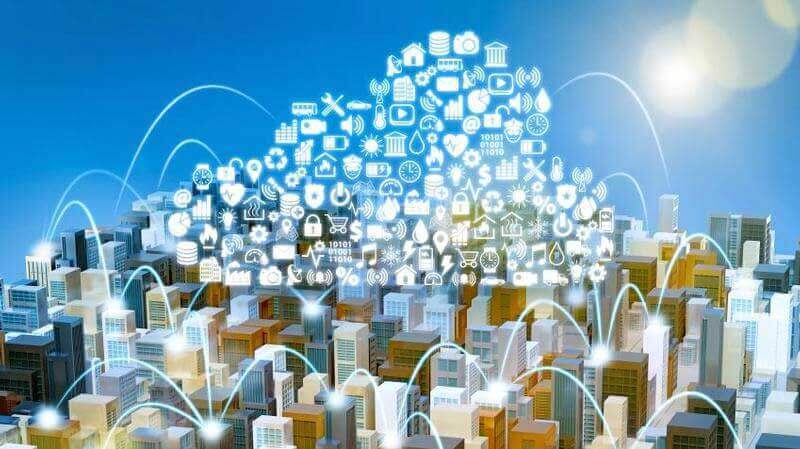- The IoT leads to significant cost savings
- Your own personal climate control follows your every move
- Connecting our elevators to the cloud
- Neuroscience is also brought into the equation
While there is no one definition of a smart building, we do know that they are full of devices and sensors that communicate with each other. And these devices are turning into entire platforms that gather data about everything – our behaviour, our likes and dislikes – in order to improve the control and communications of a building, as well as maximise efficiency, performance and occupant wellbeing.
In the not too distant future, walking into a building and having the environment adapt itself to you will be completely normal. Smart buildings of the future are instantly aware of who’s inside and what is required to make them most comfortable and most productive. Smart elevators will know when to call the maintenance company before they break down. The Internet of Things transforms buildings from mere ‘containers’ to places that actually help people become more successful. These environmentally aware, cognitive buildings are already being designed; encompassing cutting edge solutions with the Internet of Things being the catalyst for transformation.
The architects and engineers of the future will have to focus their designs on an infrastructure that supports the technology landslide that is heading our way. In this article we will look at some examples of how the IoT is set to revolutionise building design as we know it.
The IoT leads to significant cost savings
Building owners will agree that just over 70 percent of a building’s costs goes to its operation. Buildings consume approximately 43 percent of all electricity globally and half of that goes to waste because of insufficient energy management. The Internet of Things is set to change all of that. With exponential developments such as embedded sensors, cognitive analytics and pervasive connectivity, the buildings that architects and engineers will create in the future are set to transform every part of our lives and our businesses, leading to more efficient operations, which in turn leads to significant cost savings.

Your own personal climate control follows your every move
Office 3.0 is an office in Turin, Italy, designed by architect and director of the Senseable Lab at MIT Carlo Ratti. According to Ratti, buildings waste a lot of energy when cooling or heating their office spaces, even if they are not or only partly in use. The system he is designing instructs cooling, heating and lighting systems to follow people around to provide them their own personal climate control bubble. The Internet of Things technology that makes this possible uses Wi-Fi connected sensors that monitor the environment. They capture data about temperature, occupancy levels and CO2 levels. When a meeting room or an office is not in use, the smart building management system (BMS) switches of the heating/cooling and the lights. Conversely, the system also makes sure the room gets to the right temperature well in time for a meeting. Customising the lighting and heating to suit various circumstances significantly reduces energy usage. When usage and occupancy in buildings are synchronised, a more responsive and sustainable architecture can be created which can lead to 40 percent reduction in energy consumption. Occupants of smart buildings like these can use a smartphone app to set their preferred temperature and fans can be activated as soon as they sense human presence, effectively creating a thermal bubble that follows you around the building. As soon as the room becomes vacant again, the smart system will automatically return the climate control back to standby mode. The system is capable of learning usage patterns and daily routines – enabling the office environment to automatically adapt to who occupies it.
Connecting our elevators to the cloud
Every day, a billion passengers worldwide are taken up and down in vertical transportation systems – elevators – with 190 million hours worth of downtime every year due to repairs and maintenance. Elevators have been carrying people to their destinations in the sky since the first passenger elevator by Otis Elevator Company in 1857 and they really haven’t changed much; they are still electrical and mechanical systems with cabs or pods pushed by hydraulics or pulled by cables. In order to keep going up and down with a minimum amount of downtime, however, ThyssenKrupp – one of the largest technology companies in the world – has joined forces with the Microsoft’s Azure Enterprise cloud platform to connect the elevator to the cloud. With the data generated by the tens of thousands of connected elevators worldwide, they will be able to do predictive analyses and replace elevator components before they get a chance to fail. Advanced analytics and machine learning enables MAX – the algorithm in a box, attached to existing elevators – to determine the reason why a breakdown or fault happened, after which the data is recorded. MAX is then able to independently ‘predict’ the next time something will go wrong with the same component. Not only that. It will also be able to predict what is likely to go wrong. Imagine what this can do for a building’s efficiency and occupants’ wellbeing. Never mind energy savings.
Neuroscience is also brought into the equation
The fact that technology can make buildings more effective is clear. However, a building’s true intelligence is not solely based on seamless integration of and communication between sensors and devices. For a building to be truly smart, it must also create an environment in which occupants function optimally – not only from practical point of view but from a mental and emotional perspective as well. Neuroscience can help us understand how the brain responds to various types of environments and provides a powerful tool for architects and engineers tasked with designing a building. For instance, research has indicated that access to natural light as well as views of the sky and natural landscapes actually improves our brain functions. People have also responded positively – both consciously as and subconsciously – to environments with curves, instead of straight lines. Creating inspiring and harmonious environments can be achieved by optimising acoustics and reverberation but also with the use of colour – all of which affect the quality of life within a building. If the building is a school, it should enable you to learn more effectively. If the building is a hospital, it should allow you to heal faster. If it’s an office, the people in it should be inspired to be more productive and creative. The bottom line is that we should let go of the idea that a smart building is only four walls stuffed with technology.
Smart buildings do also pose some security risks
Intelligent buildings fitted with technology that manages lighting, ventilation, heat, elevators and more, also raise safety and security concerns. A number of the increasingly sophisticated and complex networks integrated into buildings do run outside the building’s direct control. Take IP-enabled security cameras, for instance. These are sometimes used instead of motion sensors to determine whether a room is occupied by a person or whether the aircon system needs to be switched on. In these types of situations, the lighting, camera and heating systems all need to be integrated. Each of these systems is also connected to a third party supplier, service provider or maintenance firm outside of the company. Not only is data from the systems in the building captured for real-time support but also for analysis purposes on a longer-term basis. It is not hard to see how this could create security problems such as hackers gaining access for malicious purposes.
Grappling with the unlimited potential of connectivity, the architects and engineers of today are tasked with designing spaces that can integrate the Internet of Things in both a functional as well as aesthetically pleasing way. With each surface and device in the home of the future connected, responsive and engineered to collect personal data on the user, they’ll need to take a new approach to spatial design.
Share via:



